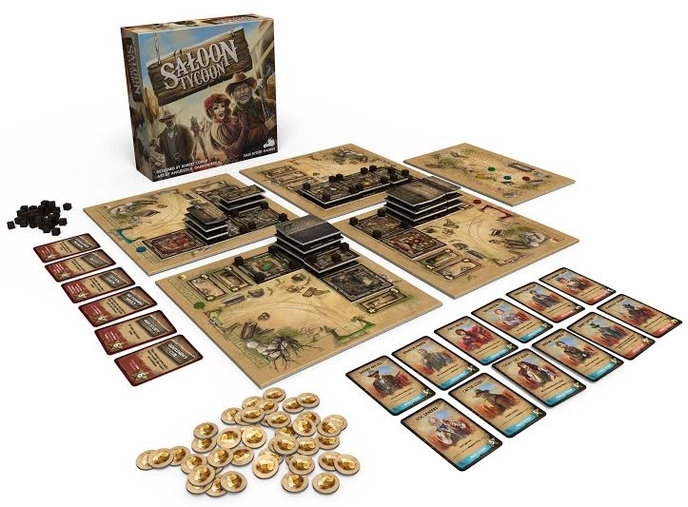
Saloon Tycoon hits the sweet spot in what I think is the real growth area in boardgaming—family strategy games that are just as challenging and enjoyable for the adults as they are for the kids. It’s a lightweight game with a relatively low luck component, with entertaining artwork and a very appealing building mechanic where players build up as well as across their boards.
Saloon Tycoon players are indeed building their saloons, starting with just one room, the main saloon, and income per turn of $1. Players earn points by building large and small rooms, by completing three full stories and adding roof tiles, by meeting conditions that bring special characters called Citizens to their saloons, and by meeting conditions on Claim cards. Each player also begins the game with a hand of three Tycoon cards, which grant players money, building cubes, extra actions, or special moves like stealing cards or money from another player.
On each turn, a player earns income equal to the number of rooms currently in his/her saloon. A player may then take one of five possible actions: buy and place a tile, draw two Tycoon cards, play one Tycoon card, bribe a character (more on that in a moment), or take $2 from the supply. A player can also buy cubes, which are used to allow players to build upward, adding second and third floors to their saloons, as a free action on a turn, for $2 per cube. Cubs must be placed on tiles immediately and you can only buy a cube if you have space to place it. Room tiles can be small or large (double the size of a small); some are unique, while others have four identical tiles of that type.
The Claim cards are straightforward—players must meet certain conditions such as having specific combinations of rooms, or having only male characters (Citizens and/or Outlaws), or having a certain room and a certain character. Each player starts the game with four Secret Claim cards and must choose two to keep, discarding the others. There are also four to six Open Claim cards on the table, two more than the number of players, that go to the first player to complete their requirements. Each card is worth a variable number of points at the end of the game, with the reward tied to the difficulty of the task. Some of the cards are particularly hard because they require players to not have something, such as having one specific character card and no others, or having only characters of one gender.
But the best part of the game, by far, is the building—deciding which rooms to add and where to add them, gaining points not when you purchase and place a tile, but when you “finish” it with cubes, three on a small tile and four on a large. Once you’ve finished a tile, you get 5 points for a small tile and 7 for a large, plus a specific bonus for finishing the tile, which could be as simple as drawing or playing another Tycoon card or as good as gaining cubes or adding a Citizen card.
There are four Outlaw cards that exist to try to slow anyone from taking too big of a lead early on in the game, three of which serve as a Harrison Bergeron-style handicap, with the fourth just taking five points away from whoever has the card at game end. The first person to meet a specific criterion for each Outlaw—having $10 on a turn or building a fifth room—gets that card, but can use a later turn to pay $6 to “bribe” that Outlaw to go hang out at someone else’s saloon instead or play a card that allows them to do the same. They’re deliberately frustrating, but can help keep a game involving kids and adults from getting out of hand without feeling too artificial.
The game ends when the supply of cubes, which is tied to the number of players, is exhausted, although there are extra cubes so that every player can get an equal number of turns and no one ends up screwed out of an opportunity to complete a room. The cube supply means games take about an hour, although I found myself wishing I’d had another turn or two to keep building because by game-end I’d reached an income level where I could build pretty much every turn.
There is one room that I suppose could be problematic for younger players, even though it’s historically accurate—the Brothel. I don’t care, and my ten-year-old daughter never asked what the room was, but it’s there if you’re sensitive to such issues.
My daughter loved the game from the start because of the building upward aspect, but was sold on the game because she was able to do something on almost every turn. You don’t wait long between moves, and after the first few turns you’re either building or one turn away from building. Our final scores tended to be closely bunched thanks to the Outlaw cards and no instances where someone was shut out of a room tile, although two players could have similar Secret Claim cards and clash over a special tile or Citizen card. The game mechanics are appropriate for a 10-year-old and possibly younger, and there’s plenty of replay value because of the huge variety of room tiles and cards—with even more value coming from the Boomtown expansions, which bring a bunch of new tiles and claims as well as two new Citizens to the game.
Keith Law is a senior baseball writer for ESPN.com and an analyst on ESPN’s Baseball Tonight. You can read his baseball content at search.espn.go.com/keith-law and his personal blog the dish, covering games, literature, and more, at meadowparty.com/blog.
